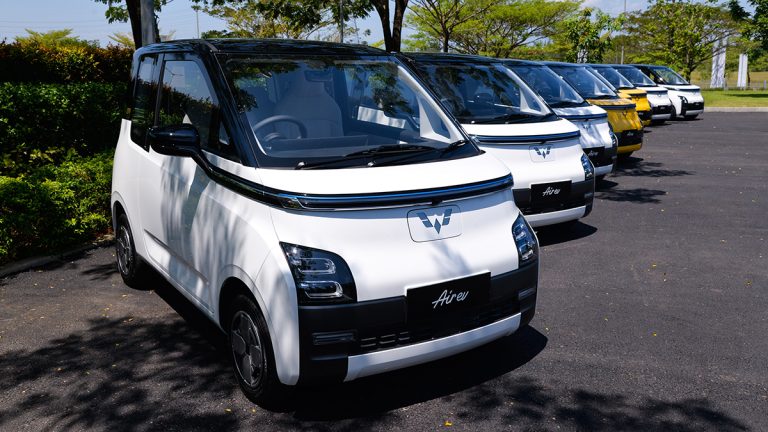The Wuling electric vehicle is an object of fascination. Priced at around $5,500 and famously outselling Tesla in China, it’s a tiny, comically square car, produced in joint partnership with General Motors and SAIC. The micro EV has been fodder for articles and YouTubers — even while it’s remained unavailable outside China.
Until last summer, that is, when Wuling attempted to go international. First stop: Indonesia. With its Air model selling at a mere $16,000 — less than half the price of alternatives — the minimalist EV was depicted in advertising as a gateway to the future, a slick solution for busy Indonesian city-dwellers.
Six months later, the Wuling Air now dominates EV sales in the country, according to the Association of Indonesia Automotive Industries (Gaikindo). Since entering Indonesia last August, it’s sold some 8,000 vehicles. The number may be small compared to the manufacturers’ sales figures in their home turfs of the U.S. and China, but it’s equivalent to 78% of the EV market in the Southeast Asian country.
The boxy car stands at 1.6 metres tall and is about the same width, with a shallow trunk for a little storage. It carries four passengers, at a slight squeeze. The exterior looks sleek and futuristic. It’s not perfect; customers complain of battery failure and the anxiety of finding charge points. But the price tag counts for a lot.
“Wuling Air EV is the cheapest electric car in Indonesia at the moment. There are no competitors [in its class],” Michael, head of marketing for a Wuling showroom in Sumatra’s Medan city, and who goes by one name, told Rest of World.
The speed of the car’s adoption in Indonesia has surprised him, independent automotive analyst Bebin Djuana told Rest of World. “There are lots of fans. The city car [meaning a compact vehicle, rather than one with a full-size cabin] is [normally] not popular in our country,” he said.
Indonesia is a land of two-wheeled vehicles, in line with the rest of Southeast Asia. Sales of scooters outnumbered cars five-to-one last year, and EV companies are growing to cater to those who need a more nimble ride. Delivery and ride-hailing giant Gojek, for one, has teamed with Taiwanese e-scooter maker Gogoro to provide hundreds of the vehicles for its employees, as Indonesia’s government aims to put 2.5 million EVs on the road by 2025. Singapore’s Ion Mobility plans to release an electric motorbike there next year.
If they can, though, many drivers would still prefer to be in a more comfortable car, protected from exposure to open traffic. Several experts — auto industry professionals and academics — who spoke to Rest of World pointed out the status of owning an EV, regardless of the brand. Wuling’s drivers in Indonesia tend to look for accessible prestige, more so than cutting down on gas fees or earning a climate-saver’s halo.
In Indonesia, “having an electric car is a prestige right now — people want to try it, even if they haven’t yet because they don’t really need it,” Samuel Nababan, a Nissan manager in Medan who has handled the Leaf EV models, told Rest of World.
A $48,000 Nissan Leaf or Hyundai Ioniq is way out of most Indonesians’ price brackets. But a Wuling — $16,000 for standard range, which lasts 250 kilometers on a full charge, and $20,000 for long-range, at 450 kilometers — is achievable.
For that price, drivers are willing to overlook some faults — even significant ones.
Three months ago, Erik Dharmawan, a garage owner in Medan, bought a Wuling Air EV. But on one of his early drives, the car suddenly turned off. A Wuling technician found a problem with the module that divides the electric current in the car, meant to allocate the energy to the operating system and engine.
“The module was replaced, and the problem never happened again,” Dharmawan told Rest of World.
He’s not alone. When a member of a Wuling Facebook group aired the same problem, several users piled into the comments below to commiserate. Maryio Laukati, the original poster, wrote that it took two weeks for the battery to be replaced, but he still wasn’t sure of the root cause.
Another Wuling owner who spoke to Rest of World was similarly baffled. “The machine turned off, power completely off,” said Irfan Rifai, a 34-year-old IT worker, in the first month after buying his Wuling EV. “Just that one time; never again after that.”
For Rifai, the lack of battery-charging infrastructure makes him use his car as transportation only within the city. “I’m not sure about driving it for inter-city trips. I’m worried that I’ll find I can only go, but not come back,” he said.
According to data from Indonesia’s state electricity company, there are 569 public vehicle-charging stations across its 6,000 inhabited islands, of which 502 are concentrated in Java and Bali, the areas with the highest population. It’s still much easier and faster to refuel at a gas station.
On the other hand, Dharmawan says the savings on fuel still make a difference. “I bought this Wuling because initially … they said they were efficient, and I wanted to try them,” he said.
He claims he now spends about 75% less per month on fueling up his car. He previously used a diesel vehicle, sometimes spending upwards of $70 a month on gasoline. With the Wuling, Dharmawan says he’s only spending around $20 on charging costs.
For 2023, Wuling Motors is aiming to educate more people on the environmental benefits of EVs and reach more customers, the company said in a statement to Rest of World.
Dino, a Jakarta-based man who runs an entire Instagram account dedicated to the Wuling Air, told Rest of World he’s currently saving to buy the EV.
“EV technology is like an era [of change], where people go from riding horses to cars,” he said. “We have to adapt to [technological] progress.”



